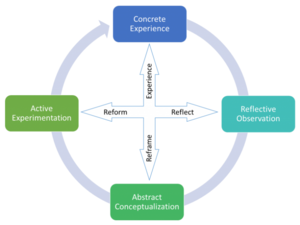Critical Reflection
|
|
Note: While this article has very useful insights on reflection, the method described below is no longer used. See 3-2-1 Reflections for more info. |
Contents
Critical Reflection
Reflection requires space and time for careful and conscious inquiry and is therefore the antithesis of the common sense which pervades many of our everyday life-worlds and the busyness which characterizes most urban lifestyles. [1]
- Caroline Humphrey
Bold Idea students reflect on their learning process at the end of each session.
Critical Reflection is defined as "The capacity to adopt an alternative standpoint in order to critique in a coherent manner so that the student can envision constructive change .
Students will have a Reflection Journal in the back of their folders. A reflection journal entry consists of three essential questions:
- What? (critque in a coherent and communicable manner)
- So What? (adopt an alternative standpoint)
- Now What? (envision constructive change)
Pay attention to the student's learning process through the day so you can help them complete their reflection journals. Below are some prompts and tips on facilitating each piece.
What?
Often, students may not be able to identify a significant episode during their experience. Help them identify the object of reflection, be it a specific scenario, interaction with a colleagues, or time period.
Example questions
- Why is it important?
- What patterns or conclusions are emerging?
- What hypotheses can you make about why this happened?
- What else could have happened?
So What?
This step can be a challenge for students. Use prompts to encourage students to consider their experience from different angles and approaches.
Collective reflection and carefully facilitated discussion helps raise alternative perspectives.
Example questions
- Why is it important?
- What patterns or conclusions are emerging?
- What hypotheses can you make about why this happened?
- What else could have happened?
Now What?
Students should be encouraged to advocate for the change and reform they believe in. Having articulated their reflection and re-framed it from multiple perspectives, students should have the ability to support their motivation for reform and advocate for change.
This is "meta-reflection" -- it goes beyond simply thinking about the experience. You have to think about you were before the experience and how you have changed as a result of it.
As students improve at this, they can begin to describe their own development and learning trajectory. This sets the stage for being able to step into the future, and plan for reform of self and reform of the world they are stepping into.
Example questions
- What actions or changes to your approach might make most sense now?
- What do I need to do better to prepare yourself for an experience like this moving forward?
- ↑ Humphrey, C. (2009). By the light of the tao. European Journal of Social Work, 12(3), 377-390. doi:10.1080/13691450902930779
